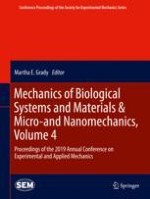Mechanics of Biological Systems and Materials & Micro-and Nanomechanics, Volume 4 of the Proceedings of the 2019 SEM Annual Conference & Exposition on Experimental and Applied Mechanics, the fourth volume of six from the Conference, brings together contributions to important areas of research and engineering. The collection presents early findings and case studies on a wide range of topics, including:
Extreme NanomechanicsIn-Situ NanomechanicsExpanding Boundaries in MetrologyMicro and Nanoscale DeformationMEMS for Actuation, Sensing and Characterization1D & 2D MaterialsCardiac MechanicsCell Mechanics Biofilms and Microbe MechanicsTraumatic Brain InjuryOrthopedic BiomechanicsLigaments and Soft Materials
